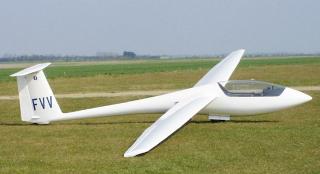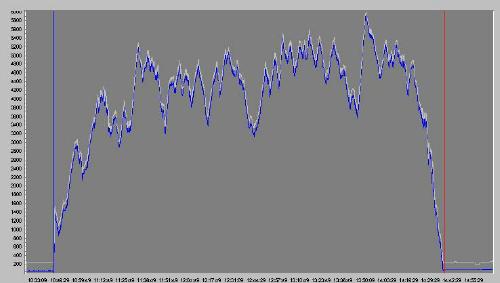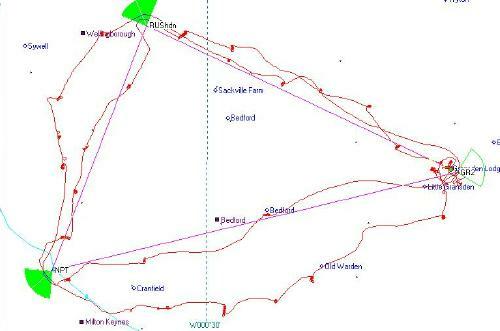
These is the story of my first cross country flight after getting my first internationally recognised qualification, the Silver C badge.
Tuesday, 16th April was forecast to be average at best, but the combination of Mike Young, the club's best pilot, appearing in the pub the previous evening and saying he was going to fly, and a dramatically improved forecast at the last minute dragged me out when I hadn't intended to go. The day was as advertised, probably one of the best days for the year, so I snagged the club's Pegase 90 and fitted my GPS, logger and water bag.
Then I got briefed for my first bash at a 100 Km triangle. This turned out to be the Slazenger, a short task that carries a club trophy. It starts and ends at Gransden Lodge with turn points at the Newport Pagnell service station and Rushden (near Wellingborough), a total of 115 km. My briefing concluded with the suggestion that, if I got round in a reasonable time, I should turn at Gransden Lodge and repeat the task in the opposite direction.

I took a cable launch at 11:42 and spent the next 13 minutes gaining height, making a start from 2800 ft at 11:57. At this time there was a breeze from the NNE. I really decided to go after climbing to 3500 ft to the south of the airfield. From there the run to Newport Pagnell Services was quite a bit south of track, passing over the Sandy TV mast, overhead at Old Warden and skirting the Luton Control Area south of Cranfield before following the A1 to Newport Pagnell services. This leg has many easily recognised landmarks including the airship hangars at Bedford, Cranfield airfield, the A1, the Milton Keynes indoor ski slope and of course Newport Pagnell Services itself, which is recognisable from a great distance. The lowest point of the entire flight, once I'd turned my back on the home base was south of Bedford, when I was down to 2900 ft.
I turned Newport Pagnell Services in moderate sink at 3600 ft and set off across rather featureless country for Rushden. The town is not easy to see from the beginning of this leg. Instead, you head a bit to the right of Wellingborough, whose industrial areas show up really well. An uneventful flight along the ideal track took me to Rushden. I skirted the west and north edges of the town to the turning point, a big, black road bridge across the river just north of the town. I rounded this at 3900 ft and once again in sink. The old joke about turn points having built-in downdrafts was proving to be all too true.
After Rushden I had a couple of climbs followed by a straight 28 km (15 nm) run past Grafham Water, over St. Neots, ending by rounding Gransden Lodge at 3200 ft at 13:42 after exactly two hours. As this was just below the FAI's maximum start height of 1000 m, I mentally declared finish for the first task, start for another run round the triangle, swung round and set off back the way I'd come.
After a slow climb back to 4500 ft I was on my way, following the same track back to Rushden, though this time using several climbs and staying between 4000 ft and 5600 ft. After rounding the turn point I headed off over Wellingborough en route for Newport Pagnell Services. After Wellingborough I hit a long sink area before starting the best climb of the flight, from 3700 ft to 5900 ft in a thermal that started as a five knotter and ended up nearer 8 kts. As I got to cloud base I thought "just one more circle" and then headed off on course in the bottom of the fluffy stuff but still able to see the ground within a 45 degree cone below me. Much to my surprise I popped out the side of the cloud a good 200 feet above its base and had a magical few minutes flying in cloud canyons before eventually dropping below cloud base.
From this height a straight run took me round Newport Pagnell Services and on course for home. I stopped to top up from 4500 ft to 5200 ft over the A1 and cruised back to Bedford along an energy line, staying in this height band. I left Bedford at 4700, knowing I had plenty of height to get home. My final glide home started from Bedford, 20 miles from home, at 4700 ft and arrived over Gransden at 2800 ft, flying at about 70 kts most of the way. I arrived at the finish point at 15:28, 1 hour 46 minutes after setting off on the second run.
The whole flight, including launch and burning off the excess height after finishing the task with a couple of spins took just under 3 hours 54 minutes. It was a super day. As the satellite image shows, the whole of England and Wales had near perfect conditions with nicely spaced cumulus over the whole area. The cloudbase was 4500 ft in late morning, rising to just under 6000 ft by mid afternoon.

Visibility was a good 12 miles and lift (and sink) were both plentiful, so I was basically cycling between 3500 and 5500 ft. The Pegase is a delight to fly. Keith Turner also flew the same task in a club Discus and had an equally good flight. I didn't see him en route, mainly because he started about 45 mins after I did and only went round once. Needless to say we were both feeling well pleased with the day's flying.


| Time | Declared | Leg (km) | Flown | Leg (km) | |
| Takeoff | 11:42 | GRL | |||
| First circuit |
|
|
|
|
|
| Start | 11:57 | GR2 | GR2 | ||
| Turn point 1 | 12:47 | NPT | 45.55 | NPT | 45.55 |
| Turn point 2 | 13:13 | RUS | 28.68 | RUS | 28.68 |
| End | 13:42 | GR2 | 37.52 | GR2 | 37.52 |
| Distance | 111.75 | 111.75 | |||
| Time | 2:00 | ||||
| Avg. speed | 55.9 kph | ||||
| Second circuit |
|
|
|
|
|
| Start | 13:42 | GR2 | GR2 | ||
| Turn point 1 | 14:24 | RUS | 37.52 | RUS | 37.52 |
| Turn point 2 | 14:57 | NPT | 28.68 | NPT | 28.68 |
| End | 15:28 | GR2 | 45.55 | GR2 | 45.55 |
| Landed | 15:36 | GRL | |||
| Distance | 111.75 | 111.75 | |||
| Time | 1:46 | ||||
| Avg. speed | 63.3 kph |
I claimed for and got the BGA's 100 km Diploma parts one and two for the second trip round the Slazenger. Part one is issued for completing a 100 km task and part two is issued for completing a 100 km task at a handicapped speed of 65 kph or faster. The Pegase has a handicap of 95, so the actual speed is multiplied by 100 / 95 to give the handicapped speed: in this case 66.6 kph. Keith had a good flight and also got parts one and two of the 100 km Diploma for his efforts.
I still need to learn to go faster: Mike Young skated round 500 Km at an average speed of just over 100 kph or 167% of my speed! The trick is to stop to gain height less often, which basically means learning to:
I used Mike's centring technique, which he explained in the pub the previous night, for the first time and like it. The improved speeds on the second half have something to do with getting better at that. I think the rest of the improvement was due to flying slower and hence stopping to climb less often. On the first time round I was following the Macready ring slavishly and going rather fast: 60 kts and up to 80+ kts at times. This meant I needed more height top-ups. The second half was taken slower (55-70 kts) and I think the resulting smaller height loss helped. I was also getting a better feel for which thermals just required slowing up in passing and which were worth stopping in, together with bailing out of initially promising but ultimately useless thermals much earlier. This is all stuff that doesn't really sink in when you're doing local soaring.
Its also true that nothing teaches you more about the characteristics of the glider you're flying than being away across country. I can 'read' the Pegase much better now and have a much better idea of its comfort zone for circling and cruising speeds.
Mike Young was second in the 15m Standard Class at the 2001 World Championships and was the guy who flew the Grob I was riding in during August, 2001 Regionals. The Cambridge Gliding Club is a good place to learn about cross country flying. The club also has a current World and European Champion (Sarah Steinberg, feminine 15m Standard class) and hoovered up 8 of the 15 BGA cups last year. The problem would be to not learn those skills in this club.